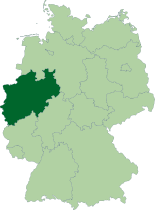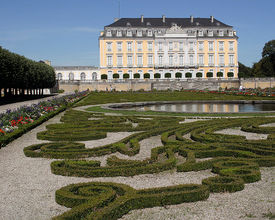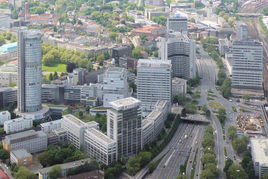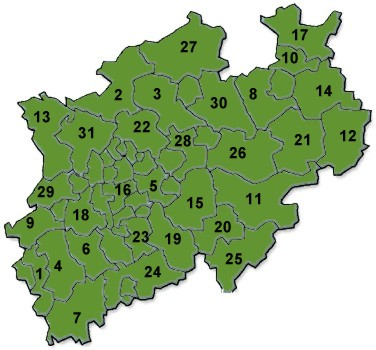North Rhine-Westphalia
| Nordrhein-Westfalen | |||
|---|---|---|---|
| — State of Germany — | |||
|
|||
 |
|||
| Coordinates: | |||
| Country | Germany | ||
| Capital | Düsseldorf | ||
| Government | |||
| - Minister-President | Hannelore Kraft (SPD) | ||
| - Governing parties | SPD / Greens | ||
| - Votes in Bundesrat | 6 (of 69) | ||
| Area | |||
| - Total | 34,084.13 km2 (13,160 sq mi) | ||
| Population (2009-12-31)[1] | |||
| - Total | 17,872,763 | ||
| - Density | 524.4/km2 (1,358.1/sq mi) | ||
| Time zone | CET (UTC+1) | ||
| - Summer (DST) | CEST (UTC+2) | ||
| ISO 3166 code | DE-NW | ||
| GDP/ Nominal | € 541,07 billion (2008 [2]) | ||
| NUTS Region | DEA | ||
| Website | www.NRW.de | ||
North Rhine-Westphalia (German: Nordrhein-Westfalen [ˈnɔɐ̯tʁaɪn vɛstˈfaːlən] , usually shortened to NRW, official short form NW) is the westernmost, the most populous, and the most economically powerful state of Germany. North Rhine-Westphalia has a population of approximately 18 million inhabitants, contributes about 22% to Germany's gross domestic product and comprises a land area of 34,083 km² (13,158 square miles). North Rhine-Westphalia is situated in the western part of Germany and shares borders with Belgium in the southwest and the Netherlands in the west and northwest. It has borders with the German states of Lower Saxony to the north and northeast, Rhineland-Palatinate to the south and Hesse to the southeast.
The capital city is Düsseldorf, and the largest city is Cologne (Köln). Other major cities are Dortmund, Essen, Duisburg, Oberhausen, Aachen, Bielefeld, Bonn, Bochum, Bottrop, Bergisch Gladbach, Mönchengladbach, Mülheim, Münster, Gelsenkirchen, Krefeld, Hagen, Hamm, Herne, Iserlohn, Leverkusen, Neuss, Paderborn, Recklinghausen, Remscheid, Siegen, Solingen, Witten, and Wuppertal.
The Ruhr Area falls entirely within North Rhine-Westphalia. From the 1960s, this region was strongly affected by a structural change away from coal mining and steel industry. Nevertheless, the Rhine-Ruhr metropolitan region is the largest agglomeration of Germany and, of all states, North Rhine-Westphalia contributes the largest fraction to the national GDP.
Contents |
Geography
The state is centred on the sprawling Rhine-Ruhr urbanised region, which contains the cities of Düsseldorf, Bonn and Cologne as well as the Ruhr Area industrial complex. The Ruhr area consists of, among others, the cities of Dortmund, Essen, Duisburg, Bochum, Gelsenkirchen and Oberhausen.
The state's area covers a maximum distance of 291 km from north to south, and 266 km from east to west.
The total length of the state's borders is 1,645 km. The following countries and states have a border with North Rhine-Westphalia:[3]
- Belgium (99 km)
- Netherlands (387 km)
- Lower Saxony (583 km)
- Hesse (269 km)
- Rhineland Palatinate (307 km)
For many people North Rhine-Westphalia is synonymous with industrial areas and agglomerating cities. But the largest part of the state is used for agriculture (almost 52%), and forests cover 25%.[4] The southern parts of the Teutoburg Forest are located in the northeast. In the southwest, Nordrhein-Westfalen shares in a small part of the Eifel, located on the borders with Belgium and Rheinland-Pfalz. The southeast is occupied by the sparsely populated regions of Sauerland and Siegerland. The northwestern areas of the state are part of the Northern European Lowlands.
The most important rivers that run at least partially through North Rhine-Westphalia include: Rhine, Ruhr, Ems, Lippe and Weser. The Pader, which runs only through the city of Paderborn, is considered the shortest river in Germany.

Location and topography
North Rhine-Westphalia is located in the west of the Federal Republic of Germany. The north widely extends into the North German Plain. The northernmost point is the NRW-Nordpunkt near Rahden in the northeast of the state. The Nordpunkt is located only 100 km to the south of the North Sea coast. The deepest natural dip is arranged in the district Zyfflich in the city of Kranenburg with 9.2m above sea level in the northwest of the state. Though, the deepest point overground results from mining. The open-pit Hambach reaches at Niederzier a deep of 293m below sea level. At the same time, this is the deepest man-made dip in Germany. Approximately half of the state is located in the relative shallow regions of the Westphalian Lowland or rather the Rhineland. In the lowlands are a few isolated mountain ranges located, among them the Hohe Mark, the Beckumer Berge, the Baumberge and the Stemmer Berge. Towards the south as well as in the east of the state, the terrain rises. There, the state has a stake in the Mittelgebirgsregionen. To this are counted the Weser Hills with the Eggegebirge, the Wiehengebirge, the Wesergebirge and the Teutoburg Forest in the east, the Sauerland, the Bergisches Land, the Siegerland and the Siebengebirge in the south, as well as the Eifel left-bank in the southwest of the state. The Rothaargebirge in the border region to Hesse exhibits elevations about 800m above sea level. The highest among these mountains is the Langenberg with 843.2m above sea level, then follow the Kahler Asten (840.7m above sea level) and the Clemensberg (839.2m above sea level).
The planimetrical ascertained centre of North Rhine-Westphalia is located in the south of Dortmund-Aplerbeck in the Aplerbecker Mark (51° 28' 42" N, 7° 33' 18" O). The westernmost point is situated near Selfkant close to the Dutch border, the easternmost near Höxter on the Weser and the southernmost near Hellenthal in the Eifel region in the southwest of the state.
Subdivisions
The state consists of five administrative regions (Regierungsbezirke), divided into 31 districts (Kreise) and 23 urban districts (kreisfreie Städte). In total, North Rhine-Westphalia has 396 municipalities (1997), including the urban districts, which are municipalities by themselves.

The districts of North Rhine-Westphalia:
|
|
||
|
|
|
The urban districts:
The five administrative regions—also called regional districts—belonging to one of two Landschaftsverbände:
- Rheinland (LVR)
- Düsseldorf
- Köln
- Westfalen-Lippe (LWL)
- Arnsberg
- Detmold
- Münster
Regions of the three original parts of North Rhine-Westphalia:
- Rhineland
- Bergisches Land
- Eifel
- Aachen
- Lower Rhine
- Rheinschiene
- Cologne/Bonn
- Westfalen
- Münsterland
- Minden-Ravensberg
- Prince-Bishopric Paderborn
- Sauerland
- Siegerland
- Tecklenburger Land
- Lippe
- Lipper Land, the region of the ancient free state
History

The state of North Rhine-Westphalia was established by the British military administration on 23 August 1946. Originally, it consisted of Westphalia and the northern parts of the Rhine Province, both formerly part of Prussia. In 1947, the former state of Lippe was merged with North Rhine-Westphalia, hence leading to the present borders of the state. The constitution of North Rhine-Westphalia was then ratified through a plebiscite.
From 1966 to 2005, North Rhine-Westphalia was continuously governed by SPD or SPD-led governments. The 2005 state election granted the CDU an unexpected victory. Their top candidate Jürgen Rüttgers formed a coalition government with the FDP. With the result of the 2010 state elections, this government lost its majority in parliament. Exploratory talks among the parties in the newly elect parliament are still ongoing, and it remains uncertain as to which coalition will constitute the next state government.
Flag
The flag of North Rhine-Westphalia is green-white-red with the combined coats of arms of the Prussian Rhine province (white line before green background, symbolizing the river Rhine), Westfalen (the white horse) and Lippe (the red rose).
According to legend the horse in the Westphalian coat of arms is the horse that the Saxon leader Widukind rode after his baptism. Other theories attribute the horse to Henry the Lion. Some connect it with the Germanic rulers Hengist and Horsa.
A regional anthem is the Lied für NRW (Song for NRW).
Politics
These are the Prime Ministers (German: Ministerpräsident) of the Federal State (German: Bundesland) of North-Rhine Westphalia (NRW):
| Minister-presidents of North Rhine-Westphalia | |||||
|---|---|---|---|---|---|
| No. | Name | Born-Died | Party affiliation | Start of Tenure | End of Tenure |
| 1 | Rudolf Amelunxen | 1888–1969 | Zentrum | 1946 | 1947 |
| 2 | Karl Arnold | 1901–1958 | CDU | 1947 | 1956 |
| 3 | Fritz Steinhoff | 1897–1969 | SPD | 1956 | 1958 |
| 4 | Franz Meyers | 1908–2002 | CDU | 1958 | 1966 |
| 5 | Heinz Kühn | 1912–1992 | SPD | 1966 | 1978 |
| 6 | Johannes Rau | 1931–2006 | SPD | 1978 | 1998 |
| 7 | Wolfgang Clement | *1940 | SPD | 1998 | 2002 |
| 8 | Peer Steinbrück | *1947 | SPD | 2002 | 2005 |
| 9 | Jürgen Rüttgers | *1951 | CDU | 2005 | 2010 |
| 10 | Hannelore Kraft | *1961 | SPD | 2010 | incumbent |

The results of the North Rhine-Westphalia state election, 2010 were as follows. Voter turnout was at 59%, a decrease of 4% over the previous election in 2005.
| Party | Party list votes | Vote % (change) | Seats (change) | Seat % | |
|---|---|---|---|---|---|
| Christian Democratic Union (CDU) | 2,681,736 | 34.6% (-10.3%) | 67 (-22) | 35.44% | |
| Social Democratic Party (SPD) | 2,675,536 | 34.5% (-2.6%) | 67 (-7) | 35.44% | |
| Alliance '90/The Greens (Die Grünen) | 940,770 | 12.1% (+5.9%) | 23 (+11) | 12.1% | |
| Free Democratic Party (FDP) | 522,436 | 6.7% (+0.6%) | 13 (+1) | 6.8% | |
| Die Linke (previously PDS and WASG) | 434,846 | 5.6% (+2.5%) | 11 (+11) | 5.82% | |
| Pirate Party | 119,581 | 1.5% (+1.5%) | - | ||
| Pro NRW | 106,932 | 1.4% (+1.4%) | - | ||
| All Others | 277,487 | 3.6% | - | - | |
| Totals | 7,759,325 | 100.0% | 181 (-6) | 100.0% | |
Economy

In the 1950s and 1960s, Westphalia was known as Land von Kohle und Stahl or the land of coal and steel. In the post-WWII recovery, the Ruhr was one of the most important industrial regions in Europe, and contributed to the German Wirtschaftswunder. As of the late 1960s, repeated crises led to contractions of these industrial branches. On the other hand, producing sectors, particularly in mechanical engineering and metal and iron working industry, experienced substantial growth. Some of former coal mining areas retain high unemployment rates. Despite this structural change and an economic growth which was under national average, the 2007 GDP of 529.4 billion Euro (21.8 percent of the total German GDP) made the land the economically most important in Germany, as well as one of the most important economical areas in the world.[5] On a per capita base, however, Northrhine-Westfalia remains one of the weaker among the Western German lands.[6] As of February 2010, the unemployment rate is 9.3%, second highest among all western German states, and in particular well above the West German average.[7]
Religion
42 %[8] of the people are Roman Catholic and 28 %[9] of the people are members of the Evangelical Church in Germany.
Notes and references
- ↑ "Amtliche Bevölkerungszahlen" (in German). Landesbetrieb Information und Technik NRW. 31 December 2009. http://www.it.nrw.de/statistik/a/daten/amtlichebevoelkerungszahlen/index.html.
- ↑ Statistisches Bundesamt
- ↑ Length of borders taken from Statistisches Jahrbuch NRW 2005, 47. Jahrgang, Landesamt für Datenverarbeitung und Statistik Nordrhein-Westfalen, p. 22
- ↑ Tatsachen über Deutschland (2003) Nordrhein-Westfalen, p. 44
- ↑ Ministerium für Wirtschaft, Mittelstand und Energie des Landes Nordrhein-Westfalen: Konjunkturindikatoren NRW
- ↑ Arbeitskreis Volkswirtschaftliche Gesamtrechnungen der Länder: Volkswirtschaftliche Gesamtrechnungen der Länder
- ↑ Bundesagentur für Arbeit: Arbeitslosenzahlen im November 2009. -Länder und Kreise-
- ↑ chiesa cattolica http://www.dbk.de/imperia/md/content/kirchlichestatistik/bev-kath-l__nd-2008.pdf
- ↑ EKD http://www.ekd.de/download/kirchenmitglieder_2007.pdf
External links
- Official Government Portal
- The Landtag of North Rhine-Westphalia
- Tourism
- Information and resources on the history of Westphalia on the Web portal "Westphalian History"
- Guidelines for the integration of the Land Lippe within the territory of the federal state North-Rhine-Westphalia of 17th January 1947
- North Rhine-Westphalia images from Cologne and Duesseldorf to Paderborn and Muenster
|
|||||||||||||
|
||||||||||







